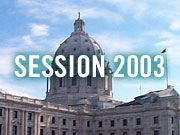Audio
More from MPR
Your Voice
| |||||||||||||||||||||||||||||||||||||||||||||||
The ethanol debate
January 26, 2003
The House is set to take up a budget-balancing plan Monday that preserves most of the state's ethanol payments. Gov. Tim Pawlenty's suggestion that the subsidies should be eliminated to balance the current budget deficit met with cries of protest from farmers and producers of the corn-based fuel. Critics of the program say ethanol producers would survive without state assistance, but supporters say profits vary from year to year and plant to plant.
St. Paul, Minn. — Gov. Pawlenty's plan would suspend $27 million in ethanol subsidies. It's one piece of his plan to erase the projected $356 million budget deficit in the current biennium. He's justified the proposal by claiming most Minnesota ethanol producers already turn profits, and he says in tight economic times, the state can't afford to support an already healthy industry.
Jim Boerboom, an assistant commissioner of agriculture, says industry studies show ethanol producers can expect a roughly 20 cents per gallon return after they deduct their operating costs. Historically, he says, that's about average.
"The 20 cents a gallon is about right in the middle. It's been as low as 10 or 11 cents a gallon, and it's been as high as in the 40 the 45 cents. So there's quite a bit of variability," he says..
On top of that return, the state provides a 20-cents-per-gallon subsidy, up to $3 million per facility. How that translates into producer profits, though, isn't entirely clear. Each cooperative's financial books are confidential, but Republican House Speaker Steve Sviggum has acknowledged healthy returns in the recent years. Sviggum shares in the returns from his two brothers' $45,000 investment in the Al-Corn plant in Claremont.
A year ago, the investment paid $20,000 -- or 44 percent -- in dividends. This year it paid $9,000 -- or 20 percent. But Sviggum notes the market can be volatile.
"That varies from year to year, depending upon either the price of corn or the price of petroleum, the price of gas. Obviously the one year it was low corn price, higher gas price. And of course that makes the dividend a little bit higher," according to Sviggum.
But tales of high dividend payments have some critics fuming.
"There are 8,700 stockholders in these companies throughout Minnesota," says David Strom, the legislative director of the conservative Taxpayers League of Minnesota. "And the other 5 million Minnesotans are paying -- are all chipping in -- to make sure that they get a fairly large dividend check. And I would like to find out how any of these people can walk into a lower-income family's house and say, 'I want you to make sure I get a new truck next year.'"
Not all ethanol plants, however, are equal. John Stone, vice-president at the Central Minnesota Ethanol Co-op in Little Falls, says last year's low corn prices and high gasoline prices allowed his facility to pay a small dividend. But over the years, he says, no one's gotten rich.
"All of us -- 800 or some producers or investors -- have had money invested in this plant up to six, seven, eight years. And we have received just a very, very, very tiny portion of a cents on a dollar since the beginning of our investment seven years ago," says Stone.
Other producers say the profitability of ethanol simply isn't the point. They say the state committed to providing the subsidy. Dale Tolifson, chair of the Central Valley Ethanol Co-op in Benson, says the state ought to abide by its promises.
"A lot of our finances and a lot of the things we did, a lot of the people that bought shares was all based on what Minnesota was going to do for us. So, it's just a matter of a deal's a deal," says Tolifson.
Critics, however, say all state spending is a committment to somebody, at some level. Rep. Michael Paymar, DFL-St. Paul, says preserving ethanol payments means reducing spending in other areas, including higher education and programs for the disadvantaged.
"Clearly legislators in the rural area are concerned about what the governor has proposed. But I think the governor makes a good point. It's very hard to balance all of these other cuts that we're making when we're subsidizing profitable companies," says Paymar.
The House budget plan, if approved, would restore 80 percent of the cuts suggested by Pawlenty. The Senate bill maintains the payments completely for 12 of the 13 subsidized plants. Pawlenty has said he'll accept the payments so long as the overall plan meets his budget-balancing criteria.
|
News Headlines
|
Related Subjects
|

